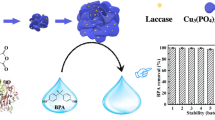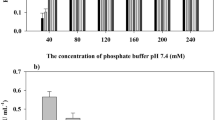Abstract
Abstract
An ultra simple 3D bioreactor was prepared via Fe3+ linking to primary amines of melamine sponge (MeS) for cooperative complex formation with enzyme. Laccase worked as a model of enzyme and no chemical modification was employed during the material preparation. The 3D structure of MeS can enhance the enzyme loading amount up to 180 µg/mg, albeit MeS as monolithic material for enzyme immobilization is rather unexplored. The 3D bioreactor (MeS@Fe3+@laccase) also improved the catalytic efficiency and showed excellent reusability, stability, and reproducibility. In this study, the as-prepared bioreactor (10 mg) was successfully applied to the degradation of dyes and micropollutants, which has shown higher efficiency than free laccase in the large-scale decolorization of dyes and showed up to almost 100% removal of 2,4,6-trichlorophenol (2,4,6-TCP) and sulfisoxazole. Therefore, the MeS@Fe3+ with low cost, good stability and easy separation can be employed as a new enzyme carrier such as trypsin and lipase in biotechnological applications.
Graphical Abstract








Similar content being viewed by others
References
Saito T, Hong P, Kato K et al (2003) Purification and characterization of an extracellular laccase of a fungus (family Chaetomiaceae) isolated from soil. Enzyme Microb Technol 33:520–526
Baldrian P (2006) Fungal laccases - occurrence and properties. Fems Microbiol Rev 30:215–242
Tavares APM, Gamelas JAF, Gaspar AR et al (2004) A novel approach for the oxidative catalysis employing polyoxometalate–laccase system: application to the oxygen bleaching of kraft pulp. Catal Commun 5:485–489
Singh AD, Kumar SR (2010) Ligninolytic fungal laccases and their biotechnological applications. Appl Biochem Biotechnol 160:1760–1788
Ghaly A, Ananthashankar R, Alhattab M et al (2014) Production, characterization and treatment of textile effluents: a critical review. J Chem Eng Process Technol 5:1–19
Jiang B, Li A et al. (2014) Biodegradation and metabolic pathway of sulfamethoxazole by Pseudomonas psychrophila HA-4, a newly isolated cold-adapted sulfamethoxazole-degrading bacterium. Appl Microb Biotechnol 98:4671–4681
Tütem E, Apak R, Ünal Ç (1998) Adsorptive removal of chlorophenols from water by bituminous shale. Water Res 32:2315–2324
Margot J, Kienle C, Magnet A et al (2013) Treatment of micropollutants in municipal wastewater: Ozone or powdered activated carbon? Sci Total Environ 461–462:480–498
Petrie B, Barden R, Kasprzyk-Hordern B (2015) A review on emerging contaminants in wastewaters and the environment: Current knowledge, understudied areas and recommendations for future monitoring. Water Res 72:3–27
Zhuo R, Yuan P, Yang Y et al (2016) Induction of laccase by metal ions and aromatic compounds in Pleurotus ostreatus HAUCC 162 and decolorization of different synthetic dyes by the extracellular laccase. Biochem Eng J 117:62–72
Jin X, Yu X, Zhu G et al (2016) Conditions optimizing and application of Laccase-mediator System (LMS) for the laccase-catalyzed pesticide degradation. Sci Rep 6:35787–35793
Margot J, Copin PJ, Gunten UV et al (2015) Sulfamethoxazole and isoproturon degradation and detoxification by a laccase-mediator system: Influence of treatment conditions and mechanistic aspects. Biochem Eng J 103:47–59
Patel SK, Choi SH, Kang YC et al (2016) Eco-friendly composite of Fe3O4-reduced grapene oxide particles for efficient enzyme immobilization. ACS Appl Mater interfaces 9:2213–2222
Samui A, Chowdhuri AR, Mahto TK et al (2016) Fabrication of a magnetic nanoparticle embedded NH2-MIL-88B MOF hybrid for highly efficient covalent immobilization of lipase. RSC Adv 6:66385–66393
Fernandes RA, Daniel-Da-Silva AL, Tavares APM et al (2017) EDTA-Cu(II) chelating magnetic nanoparticles as a support for laccase immobilization. Chem Eng Sci 158:599–605
Zhao M, Zhang X, Deng C (2015) Rational synthesis of novel recyclable Fe3O4@MOF nanocomposites for enzymatic digestion. Chem Commun 51:8116–8119
Liu WL, Lo SH, Singco B et al (2013) Novel trypsin-FITC@MOF bioreactor efficiently catalyzes protein digestion. J Mater Chem B 1:928–932
Ueda EK, Gout PW, Morganti L (2003) Current and prospective applications of metal ion–protein binding. J Chromatogr A 988:1–23
Cao Y, Wu Z, Wang T et al (2016) Immobilization of Bacillus subtilis lipase on a Cu-BTC based hierarchically porous metal-organic framework material: a biocatalyst for esterification. Dalton Trans 45:6998–7003
Wu X, Yang C, Ge J et al (2015) Polydopamine tethered enzyme/metal-organic framework composites with high stability and reusability. Nanoscale 7:18883–18886
Huang WC, Wang W, Xue C et al (2018) Effective enzyme immobilization onto a magnetic chitin nanofiber composite. ACS Sustain Chem Eng 6:8118–8124
Marciello M, Bolivar JM, Filice M et al (2013) Preparation of lipase-coated, stabilized, hydrophobic magnetic particles for reversible conjugation of biomacromolecules. Biomacromol 14:602–607
Rong J, Zhang T, Qiu F et al (2017) Preparation of efficient, stable and reusable laccase-Cu3(PO4)2 hybrid microspheres based on copper foil for decolouration of Congo red. ACS Sustain Chem Eng 5:4468–4477
Lonappan L, Liu Y, Rouissi T et al (2018) Covalent immobilization of laccase on citric acid functionalized micro-biochars derived from different feedstock and removal of diclofenac. Chem Eng J 351:985–994
Kalantari M, Kazemeini M, Tabandeh F et al (2012) Lipase immobilisation on magnetic silica nanocomposite particles: effects of the silica structure on properties of the immobilised enzyme. J Mater Chem 22:8385–8393
Kong L, Mume E, Triani G et al (2013) Optimizing radiolabeling amine-functionalized silica nanoparticles using SarAr-NCS for applications in imaging and radiotherapy. Langmuir 29:5609–5616
Patel SKS, Anwar MZ, Kumar A et al (2018) Fe2O3 yolk-shell particle-based laccase biosensor for efficient detection of 2,6-dimethoxyphenol. Biochem Eng J 132:1–8
Rouhani S, Rostami A, Salimi A et al (2018) Graphene oxide/CuFe2O4 nanocomposite as a novel scaffold for the immobilization of laccase and its application as a recyclable nanobiocatalyst for the green synthesis of arylsulfonyl benzenediols. Biochem Eng J 133:1–11
Wang B, Shangguan L, Wang S et al (2016) Preparation and application of immobilized enzymatic reactors for consecutive digestion with two enzymes. J Chromatogr A 1477:22–29
Arica MY, Salih B, Celikbicak O et al (2017) Immobilization of laccase on the fibrous polymer grafted film and studies of textile dyes degradation by MALDI-TOF-MS. Chem Eng Res Des 128:107–119
Xu R, Cui J, Li F et al (2017) Removal of 2,4,6-trichlorophenol by laccase immobilized on nano-copper incorporated electrospun fibrous membrane-high efficiency, stability and reusability. Chem Eng J 326:647–655
Linsha V, Shuhailath KA, Mahesh KV et al (2016) Biocatalytic conversion efficiency of steapsin lipase immobilized on hierarchically porous biomorphic aerogel supports. ACS Sustain Chem Eng 4:4692–4703
Ruan C, Ai K, Li X et al (2014) A superhydrophobic sponge with excellent absorbency and flame retardancy. Angew Chem Int Ed 53:5556–5560
Lei Z, Zhang G et al (2017) Thermo-responsive melamine sponges with switchable wettability by interface-initiated atom transfer radical polymerization for oil/water separation. ACS Appl Mater Interfaces 9:8967–8974
Ding Y, Xu W, Ying Y et al (2018) One-step preparation of highly hydrophobic and oleophilic melamine sponges via metal-ion-induced wettability transition. ACS Appl Mater Interfaces 10:6652–6660
Pham VH, Dickerson JH (2014) Superhydrophobic silanized melamine sponges as high efficiency oil absorbent materials. ACS Appl Mater Interfaces 6:14181–14188
Lei Z, Deng Y, Wang C (2016) Ambient-temperature fabrication of melamine-based sponges coated with hydrophobic lignin shells by surface dip adsorbing for oil/water separation. RSC Adv 6:106928–106934
Liu Q, Meng K, Ding K et al (2015) A superhydrophobic sponge with hierarchical structure as an efficient and recyclable oil absorbent. Chempluschem 80:1435–1439
Zheng W, Li Q, Su L et al (2006) Direct electrochemistry of multi-copper oxidases at carbon nanotubes noncovalently functionalized with cellulose derivatives. Electroanalysis 18:587–594
Nguyen TA, Fu CC, Juang RS (2016) Effective removal of sulfur dyes from water by biosorption and subsequent immobilized laccase degradation on crosslinked chitosan beads. Chem Eng J 304:313–324
Bradford M (1976) A rapid and sensitive method for quantitation of microgram quantities of protein utilizing the principle of proteindye binding. Anal Biochem 72:248–254
Bourbonnais R, Paice MG (1992) Demethylation and delignification of kraft pulp by Trametes versicolor laccase in the presence of 2,2′-azinobis-(3-ethylbenzthiazoline-6-sulphonate). Appl Microbiol Biotechnol 36:823–827
Kadam AA, Jang J, Lee DS (2017) Supermagnetically tuned halloysite nanotubes functionalized with aminosilane for covalent laccase immobilization. ACS Appl Mater Interfaces 9:15492–15501
Chao C, Liu J, Wang J et al (2013) Surface modification of halloysite nanotubes with dopamine for enzyme immobilization. ACS Appl Mater Interfaces 5:10559–10564
Li Y, Lei X, Bo X et al (2017) Cellulose sponge supported palladium nanoparticles as recyclable cross-coupling catalysts. ACS Appl Mater Interfaces 9:17155–17162
Papinutti VL, Forchiassin F (2010) Modification of malachite green by Fomes sclerodermeus and reduction of toxicity to Phanerochaete chrysosporium. Fems Microbiol Lett 231:205–209
Kudanga T, Nyanhongo GS, Guebitz GM et al (2011) Potential applications of laccase-mediated coupling and grafting reactions: a review. Enzyme Microb Technol 48:195–208
Chivukula M, Renganathan V (1996) Phenolic azo dye oxidation by laccase from Pyricularia oryzae. Appl Environ Microbiol 61:4374–4377
Telke AA, Joshi SM, Jadhav SU et al (2010) Decolorization and detoxification of Congo red and textile industry effluent by an isolated bacterium Pseudomonas sp. SU-EBT Biodegrad 21:283–296
Sarma R, Islam MS, Miller AF et al (2017) Layer-by-layer assembled laccase enzyme on stimuli-responsive membranes for chloroorganics degradation. ACS Appl Mater Interfaces 9:14858–14867
Zhu Y, Rong J, Zhang T et al (2017) Facile and controlled fabrication of Cu–Al layered double hydroxide nanosheets/laccase hybrid films: a route to efficient biocatalytic removal of congo red from aqueous solutions. ACS Appl Nano Mater 1:284–292
Wang S, Chen W, He S et al (2014) Mesosilica-coated ultrafine fibers for highly efficient laccase encapsulation. Nanoscale 6:6468–6472
Lin J, Fan L, Miao R et al (2015) Enhancing catalytic performance of laccase via immobilization on chitosan/CeO2 microspheres. Int J Biol Macromol 78:1–8
Li G, Nandgaonkar AG, Wang Q et al (2017) Laccase-immobilized bacterial cellulose/TiO2 functionalized composite membranes: Evaluation for photo- and bio-catalytic dye degradation. J Membr Sci 525:89–98
Acknowledgements
This work was financially supported by the National Natural Science Foundation of China (21575055).
Author information
Authors and Affiliations
Corresponding author
Ethics declarations
Conflict of interest
The authors declare that there is no conflict of interests regarding the publication of this paper.
Additional information
Publisher’s Note
Springer Nature remains neutral with regard to jurisdictional claims in published maps and institutional affiliations.
Electronic supplementary material
Below is the link to the electronic supplementary material.
Rights and permissions
About this article
Cite this article
Zou, Y., Ran, F., Huang, Q. et al. Facile Fabrication of a Novel and Reusable 3D Laccase Reactor for Efficient Removal of Pollutants from Wastewater. Catal Lett 149, 2706–2717 (2019). https://doi.org/10.1007/s10562-019-02732-8
Received:
Accepted:
Published:
Issue Date:
DOI: https://doi.org/10.1007/s10562-019-02732-8




